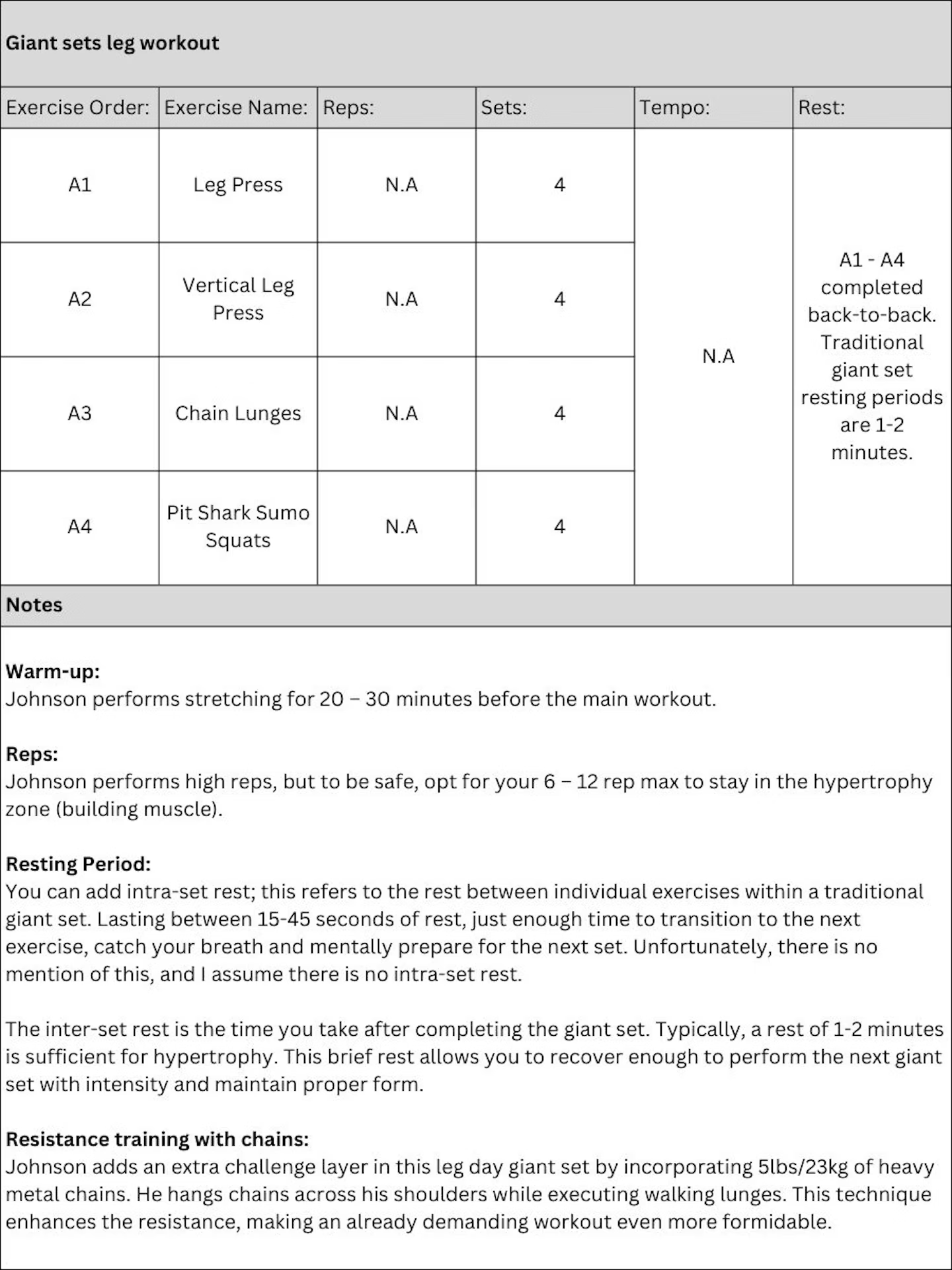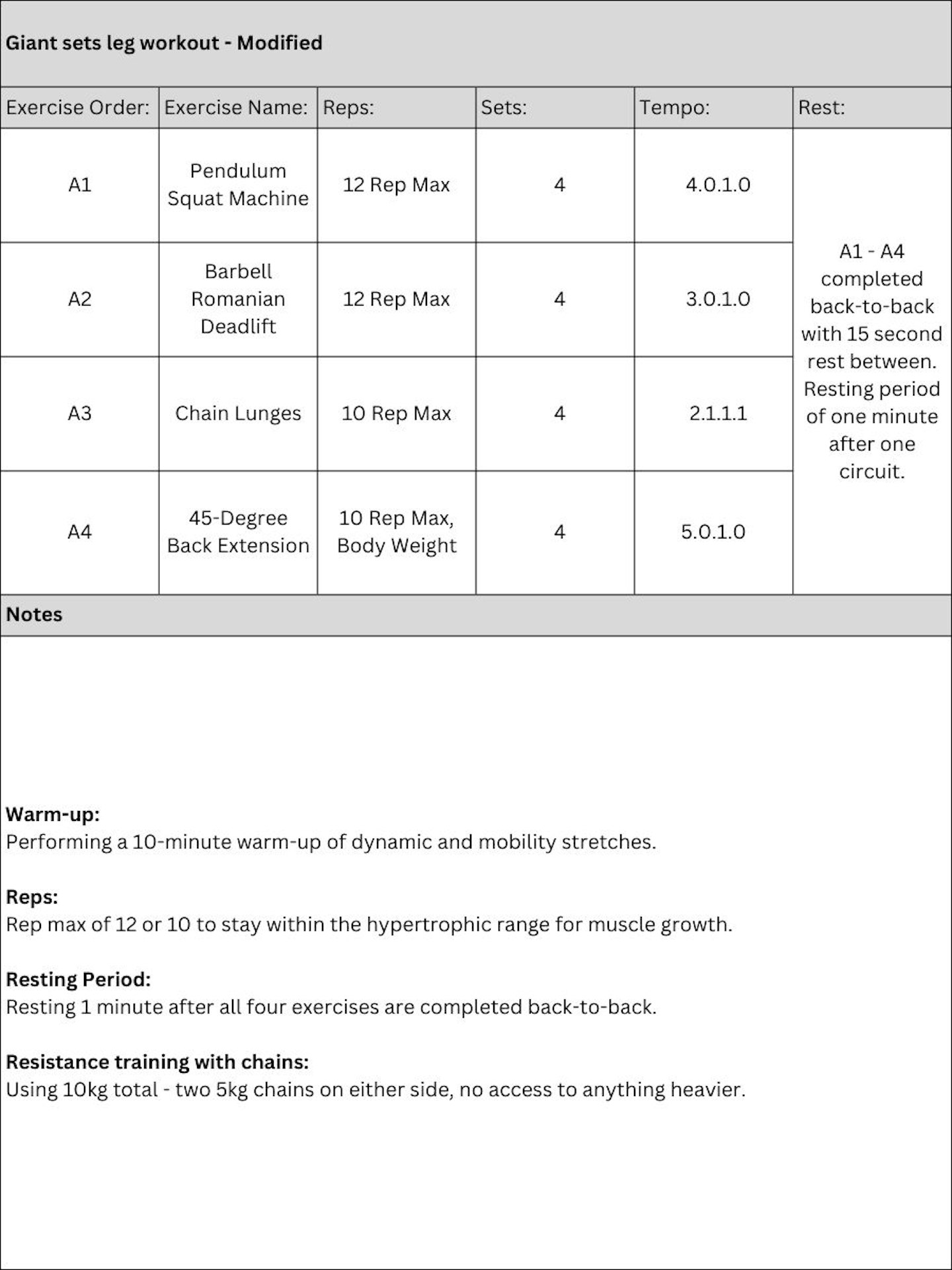Dwayne "The Rock" Johnson is not just a Hollywood icon – he's a legend. His Herculean physique has often left many questioning his ingredients for gym training success. Dwayne’s method of madness is the notorious "giant set," a resistance training method that can turn most people into muscle-galore. In this article, we'll dive headfirst into one of The Rock's gruelling leg day giant sets; I’ll give you the low down if it works.
Understanding giant sets
Before we delve deeper into Dwayne Johnson's Giant Set challenge, let's clarify what giant sets are.
Giant sets are an advanced workout technique involving back-to-back exercises with minimal rest in between or sometimes none. The aim is to target specific muscle groups intensely, creating a high level of muscular fatigue and promoting hypertrophy - muscle growth.
You may be familiar with supersets, a popular training feature where two exercises are performed back-to-back, such as bench press and bent-over rows. The tri-set is less common, consisting of three exercises completed one after the other. The next level after that is the giant set.
Here's a vid of the man performing some himself:
The pros of giant sets
Giant sets allow you to work multiple muscle groups in a single workout, making it a time-efficient way to achieve a full-body workout. By minimising rest between exercises, Giant Sets increase the intensity of your workout, pushing your muscles to their limits and potentially leading to greater muscle growth.
This method adds variety to a training routine, preventing workout boredom and plateaus. This can help you break through fitness plateaus and see new gains.
Consistently incorporating giant sets can improve cardiovascular endurance, as the rapid transitions between exercises elevate your heart rate.
You may recognise some parallels with high-intensity interval training.
The cons of giant sets
The intensity of giant sets can lead to rapid muscle fatigue, increasing the risk of improper form and potential injury, especially for beginners. While intense workouts are excellent for muscle growth, they require adequate recovery time, overtraining can lead to fatigue and potential injuries.
Furthermore, giant sets are not recommended for beginners or those with certain medical conditions. They require a high fitness level and familiarity with proper exercise form.
If you're working out in your home gym, you might find that you don't have enough equipment to hand - just some dumbbells and a kettlebell aren't going to cut it - though you'll still be able to workout with these pieces of equipment, just not to the same degree as Mr. Johnson.
Giant sets can be time-consuming, with workouts lasting longer than traditional training sessions, which may not suit everyone's schedule.
It's essential to remember proper nutrition and rest are key to success in the gym. If you need to bolster your diet with supplements to help you recover, check out our article here.
Tips for success
Start with lighter weights and fewer sets, gradually increasing intensity as you become more accustomed to the routine. I cannot stress the importance of maintaining good form, even during the inevitable fatigue of a giant set, which is essential to prevent injuries.
Support your training with a balanced diet and sufficient rest. Adequate protein intake and sleep are crucial for muscle recovery and growth. Pay attention to your body's signals. If you experience pain beyond regular muscle soreness, take a break and consult your GP/Doctor.
Consider modifying exercises or the order of your giant sets to keep your workouts fresh and challenge your muscles in new ways. Before starting your giant set, engage in a proper warm-up to reduce the risk of injury. Following your workout, perform a cool-down and stretch to aid recovery.
The Rock's giant set routine
Dwayne Johnson's weekly workout routine consists of the following:
Monday - Back & Biceps
- Focus: Back and biceps
- Training Techniques: Supersets and traditional sets
Tuesday or Wednesday - Shoulder Day:
- Focus: Shoulders
- Training Techniques: Variations of sets and exercises
Thursday - Back & Biceps:
- Focus: Back and biceps
- Training Techniques: Tri-sets and giant sets
Friday - Chest & Triceps:
- Focus: Chest and triceps
- Training Techniques: Giant Sets and traditional sets
Saturday - Leg Day:
- Focus: Legs (Quads, Hamstrings, Glutes)
- Training Techniques: Various compound and isolation exercises. The Rock’s leg day giant sets comprise four gruelling exercises designed to sculpt powerful quads and develop formidable lower body strength.
Sunday – Rest Day
- Focus: Rest and recovery.
- Training Techniques: Training Techniques: Active recovery, plenty of protein and quality sleep.
Room for improvement: Frequency and balance

Issue one: Training frequency
The frequency of training a muscle group can significantly impact muscle development. Training a muscle group only once a week may not provide sufficient stimulation for optimal growth for most people, especially beginners and particularly for those looking to maximise their gains. To address this concern, many people implement higher frequency training, for example, training all major muscle groups at least twice weekly.
Issue two: Quad-dominant
The emphasis on quad-dominant exercises in this leg day routine can reduce performance as you progress through the workout, particularly during the third and fourth exercises.
This decreased performance can result in sub-optimal training volume, potentially impacting the overall effectiveness of your workout and hindering your desired results. Performing a giant set with the same muscle group is highly intense and requires careful exercise selection, planning and being approached with caution.
Addressing the issues
A highly effective approach is incorporating antagonist and agonist exercises when setting up a giant set. This strategy ensures that while one muscle group is being pushed to its limits, the opposing muscle group can recover, maintaining the overall intensity and quality of your workout.
You can maximise the efficiency of your giant sets by linking exercises that target antagonistic muscle pairs, such as quads and hamstrings. For example, while you perform a set of Romanian deadlifts that work your hamstrings and glutes, your quads can recover from leg extensions and vice versa. This alternating pattern optimises your time at the gym and helps reduce the risk of overuse injuries by allowing adequate recovery time for both muscle groups.
To further enhance the quality of your leg day workout, it's essential to consider exercise tempo. Exercise tempo refers to the speed at which you perform each repetition, including the duration of the lifting (concentric) and lowering (eccentric) phases. A controlled tempo not only ensures safer execution but also maximises muscle engagement, time under tension and hypertrophy benefits.
Incorporating a consistent and controlled tempo into your leg day exercises can optimise muscle recruitment, enhance overall workout performance, and promote better training outcomes. This might involve focusing on slower eccentric movements or specific time intervals for each phase of the exercise to maximise muscle activation and growth.
While there's a passing reference on the website to core and abdominal training during the week, it's advisable to introduce a distinct core workout following each primary or every other training session. This addition can be instrumental in bolstering your overall stability, core strength and functional fitness.
Dwayne Johnson’s workout

A note on the benefits of chain training
Adding chains to conventional lifts is a classic bodybuilding technique that has proven effective over time. Chains serve a dual purpose in workouts - they increase the load on various exercises, adding intensity and driving greater muscle activation. The dynamic nature of chains demands increased stability and balance, changing the resistance curve - how hard or easy an exercise is at different points in the movement - of an exercise, ensuring that the muscles work even harder to maintain proper form and control.
A personal review - The Rock's leg day challenge
Embarking on The Rock's giant set challenge for an entire month proved to be a rigorous journey and one that I won't soon forget. I train legs twice per week, and the undeniable effectiveness of this workout routine was evident in the remarkable changes it brought about in my leg strength and muscle definition. Notably, my 6 rep max for the pendulum squat increased from 145 to 150 kilograms, a clear victory.
However, it's essential to acknowledge that this challenge is far from a walk in the park. The relentless nature of the workout and the added resistance from the hefty chains tested the limits of my endurance and resolve. Recognising that this challenge may not be suitable for beginners in its original form is crucial. Starting with lighter weights or reducing the number of sets can provide a more manageable introduction to this high-intensity routine.
Furthermore, due to the unavailability of specific equipment, such as the pit shark sumo squats and vertical leg press, I made the practical choice to substitute these exercises with hip and hinge movements. This adjustment aimed to ensure a more well-rounded workout while maintaining balance within the routine.
A typical leg day giant set workout lasts approximately 45 to 60 minutes, excluding the 20 to 30 minutes dedicated to warming up through dynamic and mobility stretching that Johnson does.
Reflecting on this warm-up routine, I found that dedicating 20 to 30 minutes felt excessive and, at times, hindered my performance during the main workout. I adjusted the warm-up to 10 minutes. I also performed a gentle cool down after every workout, lasting five to 10 minutes and consisting of static stretches.
Throughout the month, personal records saw substantial improvements. Clear signs of muscular gains became evident, and strength levels increased by an impressive 3.45%. This challenge delivered promising results, making the dedication to The Rock's giant set worth the effort.
Modified giant set workout

Final thoughts
Dwayne Johnson's giant set workout is a test of grit and determination. While it's undeniably tough, it yields impressive muscle growth and strength results when performed consistently and with the right adjustments. Adding chains to his leg day giant sets, The Rock takes this gruelling workout to another level. This old-school bodybuilding technique is a tried-and-true method that elevates resistance training, providing an excellent balance of challenge and rewards. So, if you're up for the challenge and ready to commit to the grind, The Rock's leg day giant set might just be your path to sculpting powerful and well-defined legs.
Simon Diamond is a contributor to What’s The Best with over a decade of expertise in fitness, nutrition and wellbeing. A former bodybuilder and fitness model winner, Simon holds multiple world records for muscular endurance and strength titles.
Subscribe to the What’s The Best Newsletter to keep up to date with more of the latest reviews and recommendations from the rest of the What’s The Best team.
